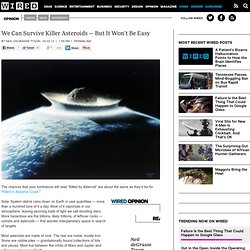

Impact: Earth! Miracle Planet - Asteroid Impact Simulation. Crater Impact. Crater Impact. Gallery Interactives: Fossils. Will It Happen Again? Examining Mass Extinctions on Earth. Overview | What is a mass extinction, and why do some scientists think human beings may be responsible for the next one?

What do we know about the past extinctions, including their likely causes? In this lesson, students learn about mass extinctions, map extinction events to a geologic timeline, and explore current ideas about whether human influences may lead to another major extinction event. Materials | Computers with Internet access and projector; research materials about mass extinctions; poster paper, pencils, markers and construction paper (optional). Www.fossilpark.org.za/pdfs/worksheets/FET/FET-Grade10-Mass_extinctions.pdf. Www.fossilpark.org.za/pdfs/worksheets/FET/FET-Grade10-Mass_extinctions.pdf. Extinction in the Classroom. Academic Level Canada-wide: grades 10 to 12 Quebec: secondary cycles 4 and 5 Description The end of the Cretaceous Period and the beginning of the Paleogene Period is marked by a thin layer of iridium-enriched dark clay.

(The time is also known as the K-Pg boundary and the Cretaceous-Paleogene boundary. The K-T Mass Extinction. Will It Happen Again? Examining Mass Extinctions on Earth. Enorme météorite en Russie (multiple vues) Best photos and video of asteroid 2012 DA14 during its February 15 flyby. A near-Earth asteroid swept safely past Earth on February 15, 2013, and astronomers in many parts of the world were ready with cameras and video equipment. At its closest to us, asteroid 2012 DA14 was within the orbit of the moon (which averages about a quarter million miles away), and closer than some high-orbiting communications satellites.
Its closest point was about 17,200 miles (27,680 kilometers) away. The asteroid was not visible to the eye as it sped harmlessly past, but earthly cameras captured it, and millions watched online in real time. The image below is from Bareket Observatory in Israel, which had a live webcast of the asteroid passage on February 15. The video below that is also from Bareket. The data stream was enormous, with more than 150K viewers overall … We continued the webcast up to about 0300am local time, much longer than the initial schedule. February 15, 2013 passage of asteroid 2012 DA14 via Bareket Observatory in Israel. Video streaming by Ustream No. NEWS. 'Armageddon' plan needed for asteroid impacts. Save the Earth: Hit asteroid with spaceship - Technology & science - Space - Space.com.
It sounds like the plot of a bad Bruce Willis movie, but some experts are saying it should be a reality. In order to prepare for massive asteroids that could aim for Earth in the future, researchers should ram a spaceship into a real asteroid to see if the space rock would shift course, scientists say. We Can Survive Killer Asteroids — But It Won't Be Easy. The chances that your tombstone will read “Killed by Asteroid” are about the same as they’d be for “Killed in Airplane Crash.”

Solar System debris rains down on Earth in vast quantities — more than a hundred tons of it a day. Most of it vaporizes in our atmosphere, leaving stunning trails of light we call shooting stars. More hazardous are the billions, likely trillions, of leftover rocks — comets and asteroids — that wander interplanetary space in search of targets. Most asteroids are made of rock. The rest are metal, mostly iron. 7 Strangest Asteroids in the Solar System.
Toutatis has made some close shaves to Earth, and passed within 1,000,000 miles (1.61 million kilometers) of Earth, or about four Moon distances, back in 2004.

Yet some rocks have made notably closer passes, and the one that has most alarmed astronomers and the public alike is Apophis. [Read: Doomsday Facts (and Fictions )] Discovered in 2004 and named after the Greek word for the evil Egyptian god of darkness, Apophis will return to the neighborhood in 2029. At the time, scientists calculated that its impacting Earth on that future pass were as high as 1 in 40, but subsequent measurements have now relegated that possibility to almost nil . When Space Attacks: The 6 Craziest Meteor Impacts. Credit: NASA/ISAS/Shinsuke Abe and Hajime Yano The life-threatening dangers here on Earth may seem like plenty.

How a Nuclear Bomb Could Save Earth From an Asteroid. A well-placed nuclear explosion could actually save humanity from a big asteroid hurtling toward Earth, just like in the movies, a new study suggests.

Scientists at Los Alamos National Laboratory, a United States Department of Energy facility in New Mexico, used a supercomputer to model nukes' anti-asteroid effectiveness. They attacked a 1,650-foot-long (500-meter) space rock with a 1-megaton nuclear weapon — about 50 times more powerful than the U.S. blast inflicted on Nagasaki, Japan, to help end World War II. The results were encouraging. Windows to the Universe. Amazing Space.